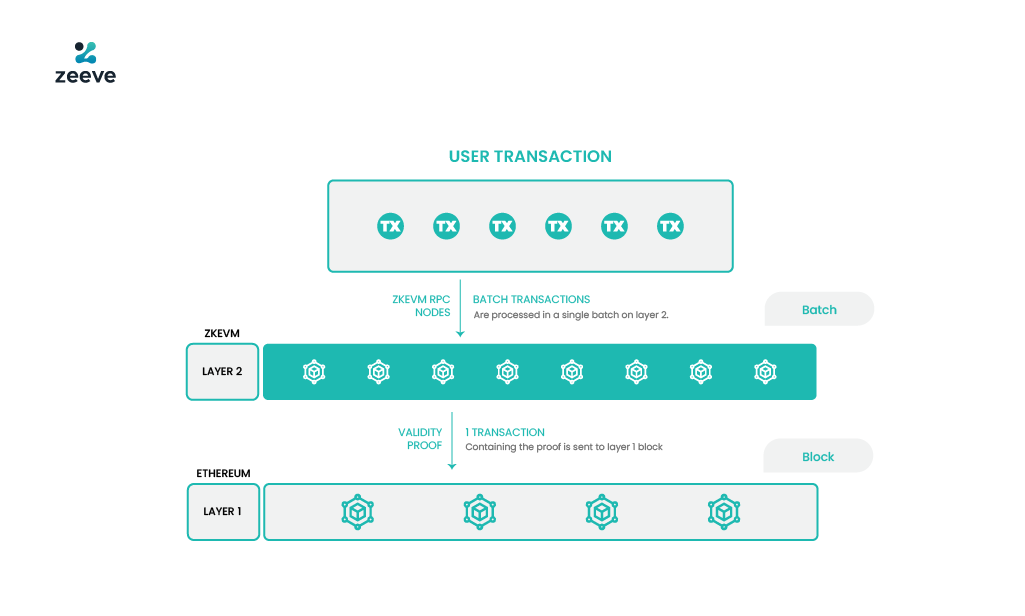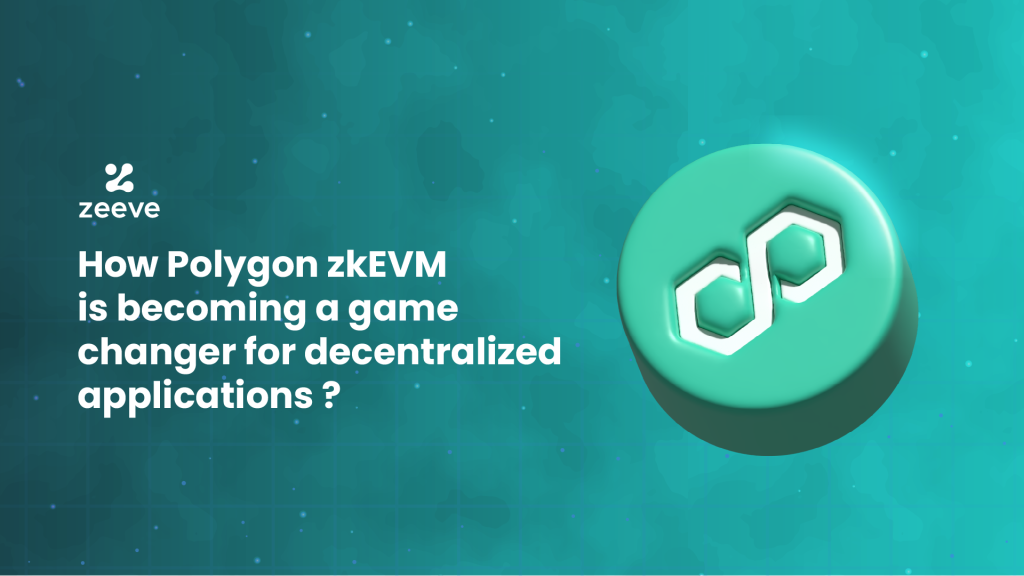Polygon zkEVM has already been proven as a feasible ecosystem for dApps and it continues to get huge traction with a whopping 12.48M transactions, 650.254K unique addresses, and TVL of $13.58M as of July, 2024. dApps deploying on Polygon zkEVM can leverage a range of benefits such as EVM equivalence, industry-leading security, and increased throughput. However, there are a lot more things that make Polygon zkEVM a game-changer solution for today’s decentralized applications.
Through this article, we will dive deeper into Polygon zkEVM and its comprehensive offering for decentralized applications, understanding Polygon zkEVM’s significance in the web3 community.

Demystifying Polygon zkEVM and its working mechanism
Polygon ZkEVM is a Layer-2 scaling solution equivalent to EVM or Ethereum Virtual Machine. Polygon ZkEVM enables web3 projects to leverage a high-performance, secure, and scalable public rollup chain for their dApps. Polygon zkEVM includes Zk + EVM, where ZK refers to Zk-rollups that batch all the transactions from the Layer-1 chain and calculate them off-chain on a Layer-2 Rollup chain. Whereas, EVM refers to a virtual machine that allows recreation of all the existing EVM opcodes for seamless migration and deployment of Ethereum smart contracts on the Polygon zkEVM infrastructure. Additionally, Zk-proof allows Polygon ZkEVM to seamlessly prove the validity of the transaction using its publicly verifiable zero-knowledge proofs.
To achieve these next-level Rollup capabilities, Polygon zkEVM includes three main components– The trusted sequencer, the trusted aggregator, and the consensus contract. These are explained below:
- Trusted sequencer: It takes transactions from layer-2, rolls them into batches, and then executes and broadcasts the batched transactions to Layer-2 network nodes. Batch data is transferred to Ethereum by the sequencer.
- Trusted Aggregrator: It generates zk-proofs for all the batches of transactions and then gets the proofs verified from the smart contract deployed on Layer-1.
- Consensus contract: It refers to the Polygon ZkEVM.sol contract that runs on Layer-1 and is responsible for storing batched data from the sequencer, thereby verifying the proof submitted by the aggregator.
Other components upholding the Polygon zkEVM include zkProver, zkEVM bridge, Zk Nodes, and RPCs, which we will discuss later in this article. Below is a graphical representation of Polygon zkEVM’s working mechanism:

What benefits Polygon zkEVM brings to dApps?
Polygon zKEVM is the ‘ideal scaling solution’ for a variety of dApps spanning DeFi, GameFi, NFT marketplace, Payments, and enterprise applications. But, how? To answer this questions, let’s learn about the main benefits of Polygon zkEVM that encourages dApps to build on its ecosystem:
100% Ethereum Equivalence, beyond compatibility
Polygon zkEVM’s ultimate goal has always been ‘Ethereum Equivalence’, not just compatibility, which this Rollup infrastructure achieves by implementing Type-2 zkEVM. With equivalence, Polygon zkEVM allows dApps to port their existing infrastructure immediately to Polygon zkEVM with fewer changes to the opcodes. All the existing frameworks, Dev tools, wallets, and smart contracts will continue to work seamlessly in a zkEVM environment.
This approach saves significant time for web3 projects that might need to invest in the traditional process of migration. The Ethereum equivalence is one of the reasons why Polygon zkEVM is able to leverage the security of Ethereum. Plus, projects building on Polygon zkEVM does not have to be hardcore familiarity with a new language except for Solidity or in some case Vyper.
Massive scalability for High-traction dApps
Different decentralized applications built on the Polygon zkEVM ecosystem can achieve massive scalability to accommodate the growing user base. Note that Polygon zkEVM, at its upper range, can offer up to 40,000 transactions per second, which is truly an unbounded scalability offering for all kinds of dApp projects.
Rapid, cost-efficient proof generation with ‘zkEVM Prover’
Polygon zkEVM tackles one of the biggest challenges that ZK-based Rollups have been facing for long, which is extremely high cost in a zero-knowledge proof generation. Polygon zkEVM adopts a special kind of zkProver that uses ‘state machine approach’ (instead of an arithmetic circuit model) for batching a batch of many transactions, providing their validity, and simultaneously generating a minimally-sized validity proof.
This zkEVM prover is powered by three methods– Stark recursion, aggregation, and composition, which allows Polygon zkEVM to produce zero-knowledge proof for a batch of transactions within 4 to 10 minutes– reducing the time significantly while improving the scalability capabilities of the Polygon zkEVM infrastructure.
Extremely low gas fee
Polygon zkEVM allows dApps to keep the gas fee as low as 0.000086 ETH. To achieve this, Polygon Zk-rollup leverages the power of ZK Proof and combines it with Polygon zkEVM’s extremely fast prover that keeps the cost between layer-1 gas schedule and actual Polygon zkEVM’s resource consumption marginal.
Also Read: Zk-EVM: An Introduction for Beginners
Greater Security and privacy
Polygon keeps a greater focus on security. Therefore, Polygon zkEVM inherits security from the underlying Layer-1, and meanwhile, it implements Polygon’s native security features with ‘Validium’ and ‘censorship resistance’ for Polygon zkEVM dApps. This enables web3 projects to build decentralized applications enriched with industry-leading security. Furthermore, Polygon zkEVM also maintains complete privacy as it processes the transactions off-chain- only the validity proofs are submitted on Layer-1 for public verification, with no disclosure about transactions and transaction data.
Account Abstraction (ERC-4337) support
Polygon zEVM wants to keep the dApp experience as simple as possible. To achieve this, Polygon zkEVM leverages account abstraction services, allowing dApp users to interact with the Polygon zEVM ecosystem using any ERC20 token. Whereas, for the purpose of staking and governance, Polygon’s native token– MATIC is used. Similarly, account abstraction also allows dApp network to accept transaction fees in any ERC20 or compatible token.
Interoperability through AggLayer Layer
Polygon zkEVM is the first protocol to plug into the Polygon’s Aggregation Layer. Knowing that interoperability is critical for improving the feasibility of decentralized applications, especially for DeFi and GameFi dApps– Polygon recently unveiled a new thesis– ‘Aggregated Blockchains’. This layer is designed to bring end-to-end interoperability across the dApps leveraging Polygon zkEVM. Basically, the AggLayer builds a unified network of dApps to enable unified liquidity and unlimited scalability. This is done through AggLayer’s two main components; a unified bridge to connect to Ethereum and a bridgeAndCall () library for Solidity contracts that allow crafting the cross-chain transactions.
DApps running on Polygon zkEVM Ecosystem
Having witnessed the tremendous success of Polygon zkEVM and realizing its next-level benefits, a variety of dApps are being built on the Polygon zkEVM ecosystem. QuickSwap, ScalarDAO, Ovix, Kredeum NFTs Factory, Obvious, DAuth Network, Owlto Finance, LI.FI exchange, Mobula API, DRPC, AuraSwap, and Add3 are some of the established Polygon zkEVM dApps that are powered by Polygon zkEVM’s ZK technology. Almost every day, we see new announcements being made on Polygon about dApps migrating to Polygon zkEVM ecosystem or launching their own Zk-rollup with Polygon CDK. This signifies the fast growing importance of Polygon and its technology for web3 enterprises and dApp projects.
Deploy & manage your Polygon zkEVM dApps with Zeeve
As discussed, Polygon zkEVM is becoming an ideal Layer-2 scaling solution for many decentralized applications. However, the process of launching or managing your dApp on the Polygon zkEVM ecosystem can be a complex and resource-intensive process. You may need a dedicated DevOps team, advanced tooling, and resources for infra management. Zeeve simplifies the deployment of your dApp with the most secure and reliable low-code blockchain infrastructure that deploy, scale, manage, and proactively monitor your dApp.
Zeeve offers everything you need for deploying Polygon zkEVM dApp– from scalable nodes to highly secure endpoints, ready plugins, and multi-cloud support– making deployment lightning-fast and hassle-free. Zeeve is ISO 27001 and SOC 2 Type 2 compliant and has enterprise-level SLA, which guarantees the reliability of our service. For more details about our Polygon zkEVM, blockchain offerings, or anything related to web3 and blockchain – drop us your queries via email or schedule a call with our blockchain experts.






















